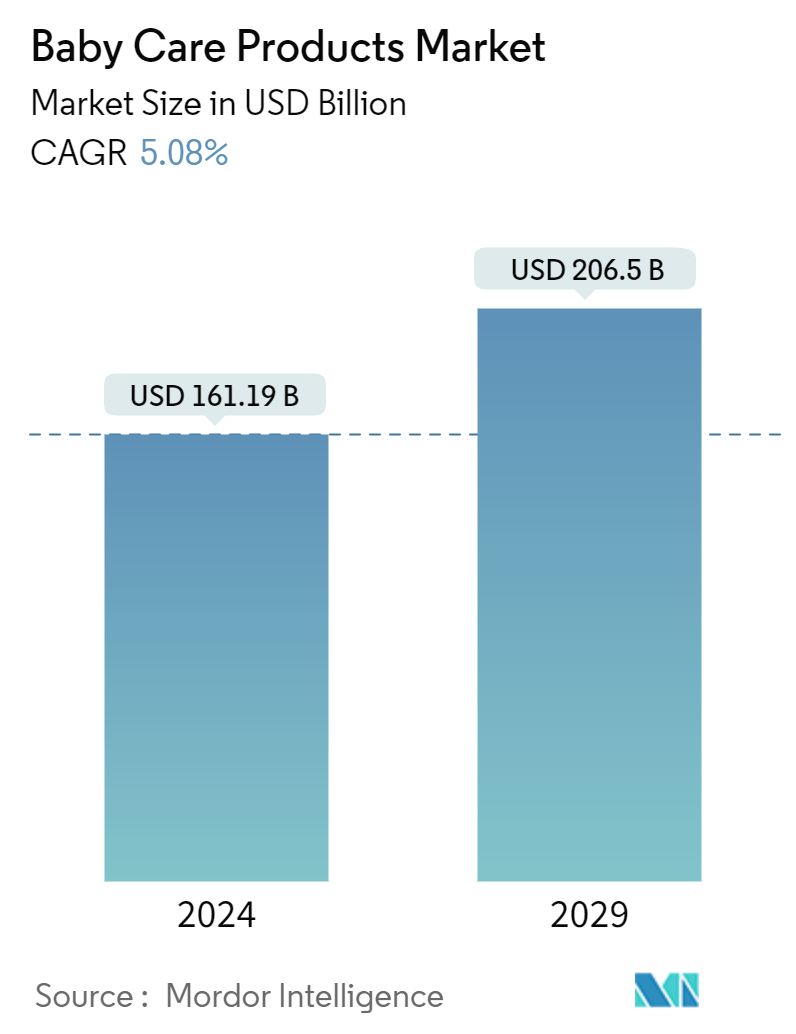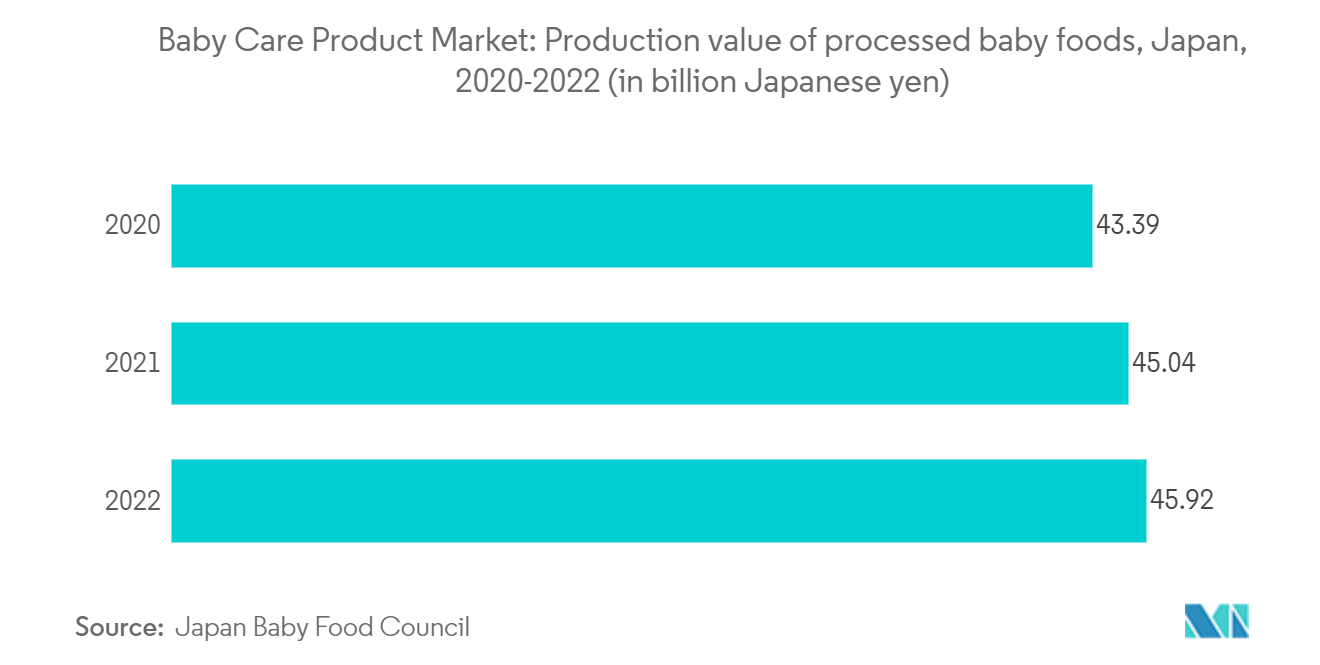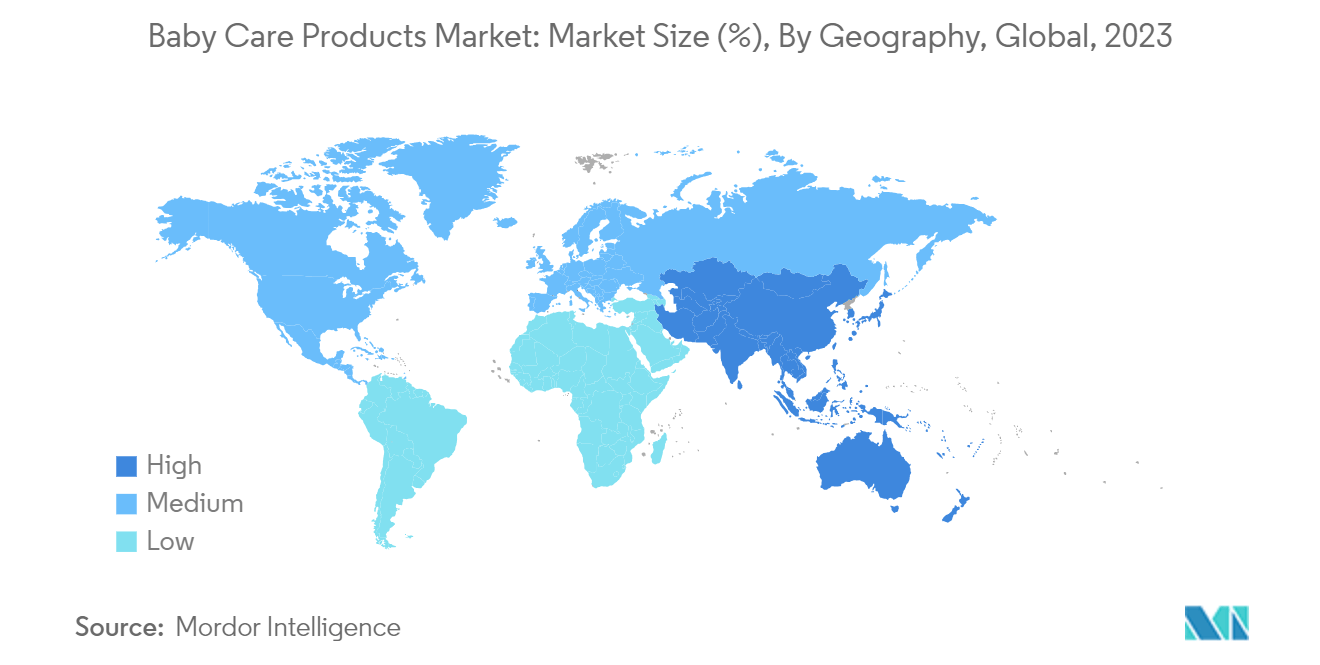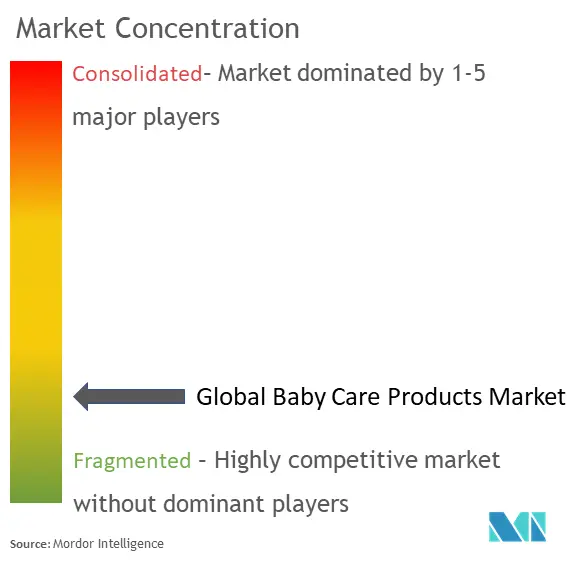Baby Care Products Market Size

| Study Period | 2019 - 2029 |
| Market Size (2024) | USD 161.19 Billion |
| Market Size (2029) | USD 206.5 Billion |
| CAGR (2024 - 2029) | 5.08 % |
| Fastest Growing Market | North America |
| Largest Market | Asia Pacific |
Major Players.webp)
*Disclaimer: Major Players sorted in no particular order |
Need a report that reflects how COVID-19 has impacted this market and its growth?
Baby Care Products Market Analysis
The Baby Care Products Market size is estimated at USD 161.19 billion in 2024, and is expected to reach USD 206.5 billion by 2029, growing at a CAGR of 5.08% during the forecast period (2024-2029).
Growing concerns about infant health are driving the market for baby care products. Environmental conditions like UV radiation, pollution, and dry climate can cause skin-related conditions such as heat rash, cradle cap, and atopic eczema, as the skin of babies is sensitive. To prevent such situations, parents prefer personal care products like baby oils, lotions, and moisturizers for their babies. Chemicals can occasionally be found in baby wipes and diapers, which can potentially irritate and cause rashes on the skin. As a result, there is a rise in consumer demand for organic baby care products. Furthermore, the demand for baby food is increasing owing to rising disposable income. Parents are willing to trade homemade food for branded organic food due to their busy lifestyles. Therefore, players are launching innovative products to meet customers' demands. For instance, in 2022, Danone launched the new Dairy & Plants Blend baby formula to meet parents' desire for feeding options suitable for vegetarian, flexitarian, and plant-based diets as per their baby's specific nutritional requirements.
Baby Care Products Market Trends
Increasing Preference for Fortified Baby Food
There is an increasing demand for fortified baby food, with rising awareness among parents about adequately fulfilling their babies' nutritional requirements. The growing demand for infant formula is influencing the market growth. Iron deficiency and anemia are usually common dietary deficiencies among children. Consequently, players in the market are introducing fortified baby food products rich in iron and folic acid for baby's physical and mental growth. For instance, in 2022, Nestlé introduced two new Little Steps multigrain portions of cereal for infants and toddlers in the United Kingdom under its SMA Nutrition range. Little Steps multigrain cereals, such as oat, barley, and wheat, for babies starting at six months, and Little Steps multigrain cereals with fruit for toddlers beginning at twelve months are the two varieties. In addition to being made without added sugars, the multigrain cereals are fortified with vital nutrients, including iron, to help support the proper cognitive development of young children.

Asia-Pacific is the Largest Market
North America and Europe highly dominate the baby care products market. However, Asia-Pacific is the largest market for baby care products due to the rising birth rate. Increasing brand penetration and a vast distribution network are driving the baby care products market in the region. The e-commerce sector is further supporting the growth of the market. Several baby care product websites entered the Indian market in the last couple of years. Leading online retailers make it easy for customers to deliver their purchases to their doorstep. The online baby-care market mainly includes baby food, skincare, toiletries/ diapers, toys, gear, and baby nurseries. Large multinational consumer goods companies are extending their core personal care brands to introduce premium baby care products. For instance, in 2023, the hair care brand Vega launched a new product category, 'Baby & Mom. ' Products in the new range include baby cleansers, water wipes, grooming tools, and breast pumps, among others. The line has a dedicated segment on Vega’s direct-to-customer website and is priced in the mid-segment of the market.

Baby Care Products Industry Overview
The global baby care market is highly competitive, with several regional and international players. Leading manufacturers in the baby care product market are leveraging opportunities from emerging markets to expand their consumer base. Key players are investing in physical retail and promotions to dilute the effect of a single promotion. Omnichannel strategies are likely to drive a return on investment. Large multinational consumer goods companies are extending their core personal care brands to introduce premium baby care products. Some major players in the market include Nestle S.A, Procter & Gamble Co., Kimberly-Clark Corp, Danone S.A, and Reckitt Benckiser Group plc.
Baby Care Products Market Leaders
Procter & Gamble Company
Nestlé S.A.
Kimberly-Clark Corporation
Danone S.A.
Reckitt Benckiser Group plc
*Disclaimer: Major Players sorted in no particular order

Baby Care Products Market News
- February 2024: MamyPoko Pants launched Extra Absorb Pants with 30+ patented technologies. The diapers are claimed to be up to 60% absorbent.
- January 2024: Pampers launched a new Pampers Premium Care Diaper – a 360-degree coverage all-in-one diaper for babies. It has an inbuilt anti-rash blanket and lotion with aloe vera to protect the baby's delicate skin from rashes.
- January 2024: Procter & Gamble Korea, a subsidiary of the global parent – Procter & Gamble Company, launched one of its newest additions to its product lineup - Pampers Baby-Dry Pants -- a baby diaper designed to provide improved absorbency. Pampers Baby-Dry Pants -- a baby diaper intended to provide enhanced absorbency.
Baby Care Products Market Report - Table of Contents
1. INTRODUCTION
1.1 Study Assumptions and Market Definition
1.2 Scope of the Study
2. RESEARCH METHODOLOGY
3. EXECUTIVE SUMMARY
4. MARKET DYNAMICS
4.1 Market Drivers
4.1.1 Concerns Among Parents Toward Baby Personal Care and Hygiene
4.1.2 Influence of Endorsements and Aggressive Marketing
4.2 Market Restraints
4.2.1 Presence of Counterfeit Products
4.3 Porter's Five Forces Analysis
4.3.1 Threat of New Entrants
4.3.2 Bargaining Power of Buyers/Consumers
4.3.3 Bargaining Power of Suppliers
4.3.4 Threat of Substitute Products
4.3.5 Intensity of Competitive Rivalry
5. MARKET SEGMENTATION
5.1 Product Type
5.1.1 Baby Skin Care
5.1.2 Baby Hair Care
5.1.3 Baby Toiletries
5.1.3.1 Baby Bath Products and Fragrances
5.1.3.2 Baby Diapers and Wipes
5.1.4 Baby Food and Beverages
5.2 Distribution Channel
5.2.1 Supermarkets/Hypermarkets
5.2.2 Convenience Stores
5.2.3 Pharmacies/Drug Stores
5.2.4 Online Retail Stores
5.2.5 Other Distribution Channels
5.3 Geography
5.3.1 North America
5.3.1.1 United States
5.3.1.2 Canada
5.3.1.3 Mexico
5.3.1.4 Rest of North America
5.3.2 Europe
5.3.2.1 United Kingdom
5.3.2.2 Germany
5.3.2.3 Spain
5.3.2.4 France
5.3.2.5 Italy
5.3.2.6 Russia
5.3.2.7 Rest of Europe
5.3.3 Asia-Pacific
5.3.3.1 China
5.3.3.2 Japan
5.3.3.3 India
5.3.3.4 Australia
5.3.3.5 Rest of Asia-Pacific
5.3.4 South America
5.3.4.1 Brazil
5.3.4.2 Argentina
5.3.4.3 Rest of South America
5.3.5 Middle-East and Africa
5.3.5.1 South Africa
5.3.5.2 Saudi Arabia
5.3.5.3 Rest of Middle-East and Africa
6. COMPETITIVE LANDSCAPE
6.1 Most Adopted Strategies
6.2 Market Share Analysis
6.3 Company Profiles
6.3.1 Nestlé S.A.
6.3.2 Procter & Gamble Company
6.3.3 Kimberly-Clark Corporation
6.3.4 Unilever PLC
6.3.5 Johnson & Johnson
6.3.6 Unicharm Corporation
6.3.7 Danone S.A.
6.3.8 Himalaya Global Holdings Ltd.
6.3.9 Abbott Laboratories
6.3.10 Royal Frieslandcampina N.V.
- *List Not Exhaustive
7. MARKET OPPORTUNITIES AND FUTURE TRENDS
Baby Care Products Industry Segmentation
Baby care products like skin care, hair care, and toiletries are specially designed for infants as per their requirements.
The baby care products market is segmented by product type, distribution channel, and geography. Based on product type, the market is segmented into baby skin care, baby hair care, baby toiletries, and baby food and beverage. Baby toiletries are further sub-segmented into baby bath products and fragrances and baby diapers and wipes. Based on the distribution channel, the market is segmented into supermarkets/hypermarkets, convenience stores, pharmacies/drug stores, online retail stores, and other distribution channels. Based on geography, the market is segmented into North America, Europe, Asia-Pacific, South America, and Middle-East and Africa.
For each segment, the market sizing and forecasts have been done on the basis of value (USD).
| Product Type | ||||
| Baby Skin Care | ||||
| Baby Hair Care | ||||
| ||||
| Baby Food and Beverages |
| Distribution Channel | |
| Supermarkets/Hypermarkets | |
| Convenience Stores | |
| Pharmacies/Drug Stores | |
| Online Retail Stores | |
| Other Distribution Channels |
| Geography | |||||||||
| |||||||||
| |||||||||
| |||||||||
| |||||||||
|
Baby Care Products Market Research FAQs
How big is the Baby Care Products Market?
The Baby Care Products Market size is expected to reach USD 161.19 billion in 2024 and grow at a CAGR of 5.08% to reach USD 206.5 billion by 2029.
What is the current Baby Care Products Market size?
In 2024, the Baby Care Products Market size is expected to reach USD 161.19 billion.
Who are the key players in Baby Care Products Market?
Procter & Gamble Company, Nestlé S.A., Kimberly-Clark Corporation, Danone S.A. and Reckitt Benckiser Group plc are the major companies operating in the Baby Care Products Market.
Which is the fastest growing region in Baby Care Products Market?
North America is estimated to grow at the highest CAGR over the forecast period (2024-2029).
Which region has the biggest share in Baby Care Products Market?
In 2024, the Asia Pacific accounts for the largest market share in Baby Care Products Market.
What years does this Baby Care Products Market cover, and what was the market size in 2023?
In 2023, the Baby Care Products Market size was estimated at USD 153.00 billion. The report covers the Baby Care Products Market historical market size for years: 2019, 2020, 2021, 2022 and 2023. The report also forecasts the Baby Care Products Market size for years: 2024, 2025, 2026, 2027, 2028 and 2029.
What are the biggest challenges in the Baby Food Market, particularly in emerging economies?
The biggest challenges in the Baby Food Market, particularly in emerging economies are a) Increasing affordability concerns b) Growing nutritional deficiencies & regulatory hurdles are urging companies to find sustainable solutions
What are the biggest challenges in the Baby Food Market, particularly in emerging economies?
The biggest challenges in the Baby Food Market, particularly in emerging economies are a) Increasing affordability concerns b) Growing nutritional deficiencies & regulatory hurdles are urging companies to find sustainable solutions
Baby Care Products Industry Report
The global baby care products market is driven by rising consumer income, evolving fashion trends, and a focus on infant health. The demand for organic, high-quality baby essentials like oils, shampoos, and diapers is increasing, alongside innovations in baby food for brain development and organic infant products. The cosmetics & toiletries segment leads, with rapid growth in baby food. Market segmentation reveals a strong preference for offline shopping, though online sales are gaining momentum, especially in the Asia-Pacific region, which is witnessing the fastest growth due to higher birth rates and e-commerce expansion. Statistics for the Baby Care Products market share, size, and revenue growth rate, created by Mordor Intelligence™ Industry Reports. Baby Care Products analysis includes a market forecast outlook and historical overview. Get a sample of this industry analysis as a free report PDF download.
